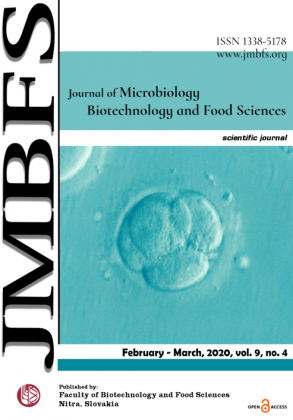EFFECT OF GERMINATION ON FREE RADICAL SCAVENGING ACTIVITIES AND ANGIOTENSIN I-CONVERTING ENZYME INHIBITORY OF MELINJO (Gnetum gnemon L) SEED PROTEINS
DOI:
https://doi.org/10.15414/jmbfs.2020.9.4.809-812Keywords:
Melinjo, Protein, Radical Scavenging, ACE–inhibitory, Gnetum gnemon, GerminationAbstract
The effect of germination on free radical scavenging activities and Angiotensin I-Converting Enzyme (ACE-I) inhibitory of melinjo (Gnetum gnemon) seed proteins was studied to determine its potential use as a nutraceutical ingredient. Investigations into the protein profiles, amino acid composition, free radical scavenging activities and ACE-I-inhibitory of proteins extracted from melinjo seed during germination (0 to 21 days) were carried out. The concentration of amino acids detected in the melinjo seed samples ranged from 0.30 to 12.75 g/100 g protein and the degree of hydrolysis during germination at 21st days was significantly highest than that of either (0-14 days). Furthermore, with all samples a large small-sized peptides degree (<10 kDa) was observed with an increasing degree of hydrolysis value. The free radical scavenging activities were measured using different standard methods, and ACE-I inhibitory activity was determined using in vitro ACE-I inhibitory assay. The time of germination showed a significant effect (p<0.05) on free radical scavenging (ABTS2+, DPPH, O2•, and OH•) activities and ACE-I inhibitory. The above results indicated that germination time has positively affected ACE-I inhibitory activity and free radical scavenging activities.Downloads
Download data is not yet available.
Downloads
Published
2020-02-03
How to Cite
Noviyanti, E., Supriyadi, A., Sekar Arum, L., R. Akbar, R., & Agus Siswoyo, T. (2020). EFFECT OF GERMINATION ON FREE RADICAL SCAVENGING ACTIVITIES AND ANGIOTENSIN I-CONVERTING ENZYME INHIBITORY OF MELINJO (Gnetum gnemon L) SEED PROTEINS . Journal of Microbiology, Biotechnology and Food Sciences, 9(4), 809–812. https://doi.org/10.15414/jmbfs.2020.9.4.809-812
Issue
Section
Food Sciences
License
Copyright (c) 2020 Erni Noviyanti, Anang Supriyadi, Laras Sekar Arum, Rida R. Akbar, Tri Agus Siswoyo

This work is licensed under a Creative Commons Attribution 4.0 International License.
All papers published in the Journal of Microbiology, Biotechnology and Food Sciences are published under a CC-BY licence (CC-BY 4.0). Published materials can be shared (copy and redistribute the material in any medium or format) and adapted (remix, transform, and build upon the material for any purpose, even commercially) with specifying the author(s).




